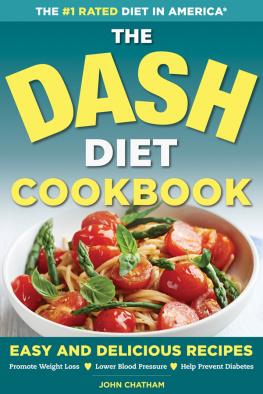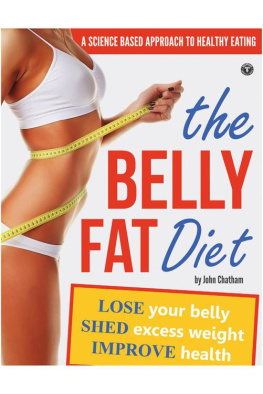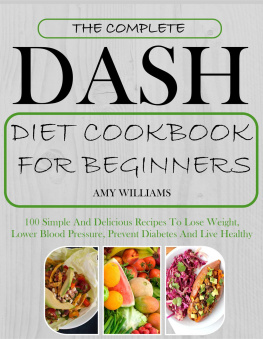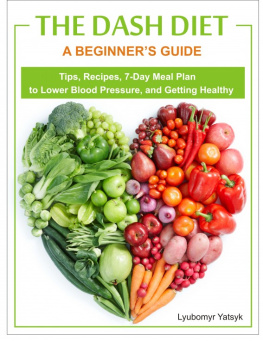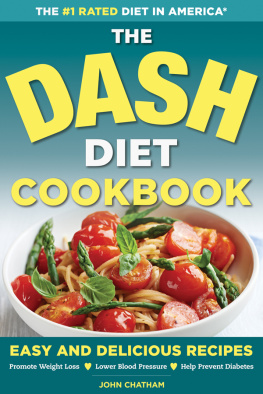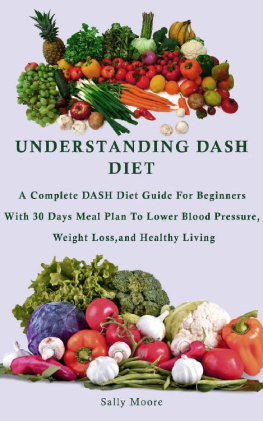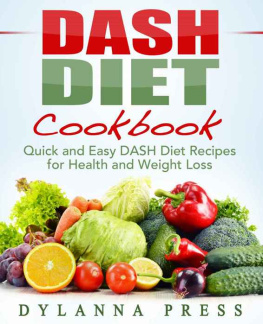INTRODUCTION
D o you really want to entrust your health to a fad? Do you know if any of the diet plans in books or on the Internet really work? Do you trust any of the diets out there?
Its difficult enough admitting that you need and want help controlling your weight and your health. What makes it even more challenging is that there is so much conflicting information about how to go about losing weight and gaining back ones good health. Picked by US News & World Report as its number-one choice in Best Diets Overall, Best Diets for Healthy Eating, and Best Diabetes Diets, the DASH diet rises above the noise of the gimmicky weight-loss plans year after year. The DASH diet is nutritionally sound, based on extensive scientific research, and has received widespread support and approval from the health and medical communities. On the DASH diet, you wont starve or feel deprived, and best of all, youll be lowering your blood pressure and cholesterol levels; reducing your risk of heart disease, diabetes, and stroke; and losing weight, all while enjoying rosemary chicken, seafood fettuccine, and more.
This medically developed plan works because it was designed primarily to improve ones health. Instead of being stuck in the diet doldrums, you will feel satisfied and full of energy, because the DASH diet Cookbook diet isnt about eating less foodits about eating the right foods for optimal health.
The DASH Diet Cookbook includes streamlined program details so you can get started on the diet right away, and best of all, it includes more than a hundred DASH diet recipes designed with your taste buds and your health in mind.
SECTION ONE
The DASH Diet Basics

WHAT YOU NEED TO KNOW ABOUT THE DASH DIET
The History of the DASH Diet
In response to the growing problem of high blood pressure in the United States, the National Institutes of Health (NIH) provided funding in 1992 for research into a dietary solution to hypertension. The goal was to create Dietary Approaches to Stop Hypertension (DASH).
The National Heart, Lung, and Blood Institute (NHLBI) conducted this research with the help of five of the most respected medical research institutions in the country. Together, these five facilities conducted the most extensive and exhaustive research to date on nutritional solutions for the growing problem of hypertension.
Teams of doctors, nutritionists, nurses, and statisticians worked cooperatively between their respective institutions on randomized control trials. Each facility chose and studied its own groups of participants to ensure the most accurate research results. More than eight thousand people went through the screening process, and the researchers specifically sought to fill at least two-thirds of the spots with people at high risk of hypertension.
Two DASH trials were conducted in all. By the end of the second study, the results showed that a diet consisting of high fiber, low-fat dairy, plenty of fresh fruits and vegetables, lean protein, plus lower sodium and sugar intake produced blood pressure reduction in people who were considered prehypertensive. The hypertensive participants had an even higher reduction. These results were apparent after just thirty days on the DASH diet.
These studies, along with additional research, showed that the DASH diet not only reduced blood pressure but cholesterol and body fat, particularly around the abdomen. These findings are the reason that the DASH diet is recommended by medical organizations such as the American Medical Association, the American Heart Association, and many others.
The 2012 Dietary Guidelines for Americans recommend the DASH eating plan for everyone, including children and the elderly. The DASH diet even formed the basis for the MyPlate dietary guidelines (the new food pyramid) generated by the United States Department of Agriculture (USDA).
An Overview of the DASH Diet Plan
- Reduces sodium to lower hypertension or the risk of hypertension. Choose the standard DASH diet that allows up to 2,300 milligrams (mg) of sodium per day or a low-sodium version that allows up to 1,500 mg of sodium per day. The typical American diet includes as much as 3,500 mg of sodium per day!
- Increases fiber to reduce blood pressure, steady blood sugar levels, and aid in weight loss. The DASH diet provides more fresh fruits and vegetables than most people are used to eating, as well as a healthful selection of whole grains.
- Reduces saturated fat and trans fat in order to increase heart health, lower LDL (bad) cholesterol, raise HDL (good) cholesterol, aid in weight loss, and decrease risks and symptoms of heart disease, diabetes, and metabolic syndrome. Trans fats (from processed and fried foods) are omitted, and foods low in saturated fats, such as low-fat dairy, lean meats, and seafood, are encouraged.
- Increases healthful fats by eating nuts, seeds, fish, avocado, and other omega-3rich foods.
- Helps reduce blood pressure by limiting alcohol and caffeine.
- Ensures proper levels of the minerals shown to reduce high blood pressure, such as potassium and magnesium. Eating a wide variety of foods containing minerals, such as bananas, legumes (beans), and leafy greens, boosts mineral intake.
- Reduces the risk of type 2 diabetes and metabolic syndrome while lowering abdominal fat (a leading indicator of both). Sugary foods are limited to no more than five per week.
The DASH Diets Effect on Your Health
Unlike most diet plans, the DASH diet wasnt created as a means of losing weight; it was designed to reduce high blood pressure, which in turn helps prevent heart disease and stroke.
The DASH Diet and High Blood Pressure
Following the DASH diet planparticularly the low-sodium version of the diethas been shown to have a direct impact on high blood pressure. This combination of specific nutrients with a low sodium intake has produced significant positive results in every major study conducted.
If youre at a high risk of developing high blood pressure due to your ethnicity (African Americans are in this high-risk group), lifestyle choices (such as smoking and high sodium intake), or weight (obesity is a leading indicator of hypertension risk), the DASH diet is the recommended diet for reducing your risk.
The DASH Diet and Type 2 Diabetes
It has been shown that the symptoms and severity of type 2 diabetes can be greatly lessened with a DASH-style diet, and that the condition can sometimes even be reversed with these dietary changes.
All of the foods included in the DASH diet are recommended to help improve the health of those with type 2 diabetes, but some are particularly effective. Nuts can improve glucose control in diabetics. Similarly, the high fiber content of the diet works to slow the absorption of sugar, which helps to prevent serious swings in blood sugar levels. The high level of antioxidants in all the DASH-recommended fresh fruits and vegetables can also help to prevent or reduce type 2 diabetes complications.
One of the most important ways that the DASH diet can help those with or at risk for type 2 diabetes is in weight loss. Excess body fatparticularly abdominal fatis one of the biggest contributors to insulin insensitivity. It also further increases the risk of heart disease for diabetics.
The DASH Diet and Metabolic Syndrome

